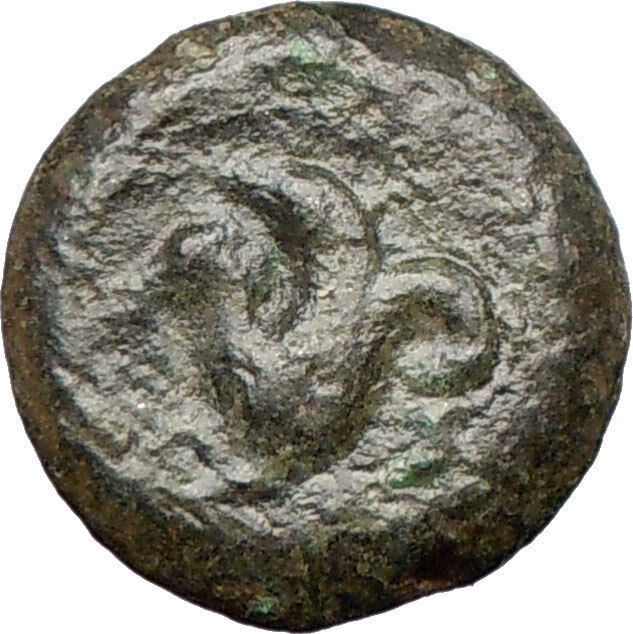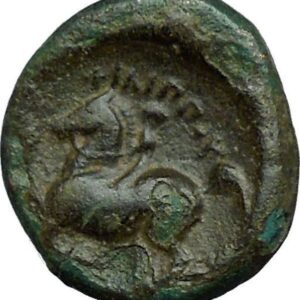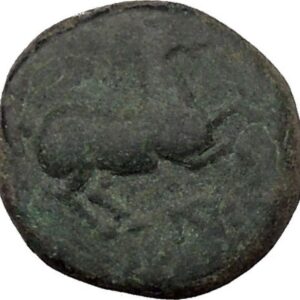|
Seleukid Empire
Seleukos II Kallinikos – King: 246-225 B.C.
Bronze 20mm (8.09 grams) Antioch mint, struck circa 244-225 B.C.
Reference: HGC 9, 327 Rare R1-R2; SC 693-694 and 697
Laureate head of Apollo right.
ΒΑΣΙΛΕΩΣ / ΣΕΛΕΥΚΟΥ either side of tripod.
You are bidding on the exact item pictured, provided with a Certificate of Authenticity and Lifetime Guarantee of Authenticity.
 In Greek and Roman mythology, Apollo, is one of the most important and diverse of the Olympian deities. The ideal of the kouros (a beardless youth), Apollo has been variously recognized as a god of light and the sun; truth and prophecy; archery; medicine and healing; music, poetry, and the arts; and more. Apollo is the son of Zeus and Leto, and has a twin sister, the chaste huntress Artemis. Apollo is known in Greek-influenced Etruscan mythology as Apulu. Apollo was worshiped in both ancient Greek and Roman religion, as well as in the modern Greco–Roman Neopaganism. In Greek and Roman mythology, Apollo, is one of the most important and diverse of the Olympian deities. The ideal of the kouros (a beardless youth), Apollo has been variously recognized as a god of light and the sun; truth and prophecy; archery; medicine and healing; music, poetry, and the arts; and more. Apollo is the son of Zeus and Leto, and has a twin sister, the chaste huntress Artemis. Apollo is known in Greek-influenced Etruscan mythology as Apulu. Apollo was worshiped in both ancient Greek and Roman religion, as well as in the modern Greco–Roman Neopaganism.
As the patron of Delphi (Pythian Apollo), Apollo was an oracular god – the prophetic deity of the Delphic Oracle. Medicine and healing were associated with Apollo, whether through the god himself or mediated through his son Asclepius, yet Apollo was also seen as a god who could bring ill-health and deadly plague as well as one who had the ability to cure. Amongst the god’s custodial charges, Apollo became associated with dominion over colonists, and as the patron defender of herds and flocks. As the leader of the Muses (Apollon Musagetes) and director of their choir, Apollo functioned as the patron god of music and poetry. Hermes created the lyre for him, and the instrument became a common attribute of Apollo. Hymns sung to Apollo were called paeans.
In Hellenistic times, especially during the third century BCE, as Apollo Helios he became identified among Greeks with Helios, god of the sun, and his sister Artemis similarly equated with Selene, goddess of the moon. In Latin texts, on the other hand, Joseph Fontenrose declared himself unable to find any conflation of Apollo with Sol among the Augustan poets of the first century, not even in the conjurations of Aeneas and Latinus in Aeneid XII (161-215). Apollo and Helios/Sol remained separate beings in literary and mythological texts until the third century CE.
A sacrificial tripod was a type of altar used by the ancient Greeks. The most famous was the Delphic tripod, on which the Pythian priestess took her seat to deliver the oracles of the deity. The seat was formed by a circular slab on the top of the tripod, on which a branch of laurel was deposited when it was unoccupied by the priestess. In this sense, by Classical times the tripod was sacred to Apollo. The mytheme of Heracles contesting with Apollo for the tripod appears in vase-paintings older than the oldest written literature. The oracle originally may have been related to the primal deity, the Earth.
Another well-known tripod was the Plataean Tripod, made from a tenth part of the spoils taken from the Persian army after the Battle of Plataea. This consisted of a golden basin, supported by a bronze serpent with three heads (or three serpents intertwined), with a list of the states that had taken part in the war inscribed on the coils of the serpent. The golden bowl was carried off by the Phocians during the Third Sacred War; the stand was removed by the emperor Constantine to Constantinople (modern Istanbul), where it still can be seen in the hippodrome, the Atmeydanı, although in damaged condition, the heads of the serpents disappeared however one is now on display at the nearby Istanbul Archaeology Museums. The inscription, however, has been restored almost entirely. Such tripods usually had three ears (rings which served as handles) and frequently had a central upright as support in addition to the three legs.
Tripods frequently are mentioned by Homer as prizes in athletic games and as complimentary gifts; in later times, highly decorated and bearing inscriptions, they served the same purpose. They also were used as dedicatory offerings to the deities, and in the dramatic contests at the Dionysia the victorious choregus (a wealthy citizen who bore the expense of equipping and training the chorus) received a crown and a tripod. He would either dedicate the tripod to some deity or set it upon the top of a marble structure erected in the form of a small circular temple in a street in Athens, called the street of tripods, from the large number of memorials of this kind. One of these, the Choragic Monument of Lysicrates, erected by him to commemorate his victory in a dramatic contest in 335 BC, still stands. The form of the victory tripod, now missing from the top of the Lysicrates monument, has been rendered variously by scholars since the eighteenth century.
The scholar Martin L. West writes that the sibyl at Delphi shows many traits of shamanistic practices, likely inherited or influenced from Central Asian practices. He cites her sitting in a cauldron on a tripod, while making her prophecies, her being in an ecstatic trance state, similar to shamans, and her utterings, unintelligible.
According to Herodotus (The Histories, I.144), the victory tripods were not to be taken from the temple sanctuary precinct, but left there for dedication.
Seleucus II Callinicus or Pogon (Greek: Σέλευκος Β’ Καλλίνικος , the epithets meaning “beautiful victor” and “bearded”, respectively), was a ruler of the Hellenistic Seleucid Empire, who reigned from 246 to 225 BC. After the death of this father, Antiochus, he was proclaimed king by his mother, Laodice in Ephesos, while her partisans at Antioch murdered Berenice and her son, another Antiochus.
This dynastic feud began the Third Syrian War. Ptolemy III, who was Berenice’s brother and the ruler of Egypt, invaded the Seleucid Empire and marched victoriously to the Tigris or beyond. He received the submission of the Seleucid Empire’s eastern provinces, while Egyptian fleets swept the coast of Asia Minor.
Seleucus managed to maintain himself in the interior of Asia Minor. When Ptolemy returned to Egypt, Seleucus recovered Northern Syria and the nearer provinces of Iran. However, Antiochus Hierax, a younger brother of Seleucus, was set up as a rival in Asia Minor against Seleucus by a party to which Laodice herself adhered.
At Ancyra (about 235 BC) Seleucus sustained a crushing defeat and left the country beyond the Taurus to his brother and the other powers of the peninsula. Seleucus then undertook an anabasis to regain Parthia, the results of which came to nothing. According to some sources, he was even taken prisoner for several years by the Parthian king. Other sources mention that he established a peace with Arsaces I, who recognized his sovereignty.
In Asia Minor, Pergamon now rose to greatness under Attalus I. Antiochus Hierax, after a failed attempt to seize his brother’s dominions when his own were vanishing, perished as a fugitive in Thrace in 228 or 227 BC.
About a year later, Seleucus was killed by a fall from his horse. Seleucus II married his cousin Laodice II, by whom he had five children and among them were: Antiochis, Seleucus III Ceraunus and Antiochus III the Great. He was succeeded by his elder son, Seleucus III Ceraunus, and later by his younger son Antiochus III the Great.
External links
- Seleucus II Callinicus entry in historical sourcebook by Mahlon H. Smith
This article incorporates text from a publication now in the public domain: Chisholm, Hugh, ed (1911). Encyclopædia Britannica (11th ed.). Cambridge University Press.
|
Seleucus II Callinicus
Seleucid dynasty
Born: ? Died: 225 BC |
Preceded by
Antiochus II Theos |
Seleucid King
246–225 BC |
Succeeded by
Seleucus III Ceraunus |
Seleucid Empire
Σελεύκεια
Seleúkeia |

|
312 BC–63 BC |
↓ |
|
|
The Seleucid Empire in 301 BC.
|
The Seleucid Empire was a Hellenistic state ruled by the Seleucid dynasty founded by Seleucus I Nicator following the division of the empire created by Alexander the Great. Seleucus received Babylonia and, from there, expanded his dominions to include much of Alexander’s near eastern territories. At the height of its power, it included central Anatolia, the Levant, Mesopotamia, Kuwait, Persia, Afghanistan, Turkmenistan, and northwest parts of India.
The Seleucid Empire was a major center of Hellenistic culture that maintained the preeminence of Greek customs where a Greek-Macedonian political elite dominated, mostly in the urban areas. The Greek population of the cities who formed the dominant elite were reinforced by emigration from Greece. Seleucid expansion into Anatolia and Greece was abruptly halted after decisive defeats at the hands of the Roman army. Their attempts to defeat their old enemy Ptolemaic Egypt were frustrated by Roman demands. Much of the eastern part of the empire was conquered by the Parthians under Mithridates I of Parthia in the mid-2nd century BC, yet the Seleucid kings continued to rule a rump state from the Seleukid Kingdom until the invasion by Armenian king Tigranes the Great and their ultimate overthrow by the Roman general Pompey.
|





 In Greek and Roman mythology, Apollo, is one of the most important and diverse of the Olympian deities. The ideal of the kouros (a beardless youth), Apollo has been variously recognized as a god of light and the sun; truth and prophecy; archery; medicine and healing; music, poetry, and the arts; and more. Apollo is the son of Zeus and Leto, and has a twin sister, the chaste huntress Artemis. Apollo is known in Greek-influenced Etruscan mythology as Apulu. Apollo was worshiped in both ancient Greek and Roman religion, as well as in the modern Greco–Roman Neopaganism.
In Greek and Roman mythology, Apollo, is one of the most important and diverse of the Olympian deities. The ideal of the kouros (a beardless youth), Apollo has been variously recognized as a god of light and the sun; truth and prophecy; archery; medicine and healing; music, poetry, and the arts; and more. Apollo is the son of Zeus and Leto, and has a twin sister, the chaste huntress Artemis. Apollo is known in Greek-influenced Etruscan mythology as Apulu. Apollo was worshiped in both ancient Greek and Roman religion, as well as in the modern Greco–Roman Neopaganism.





